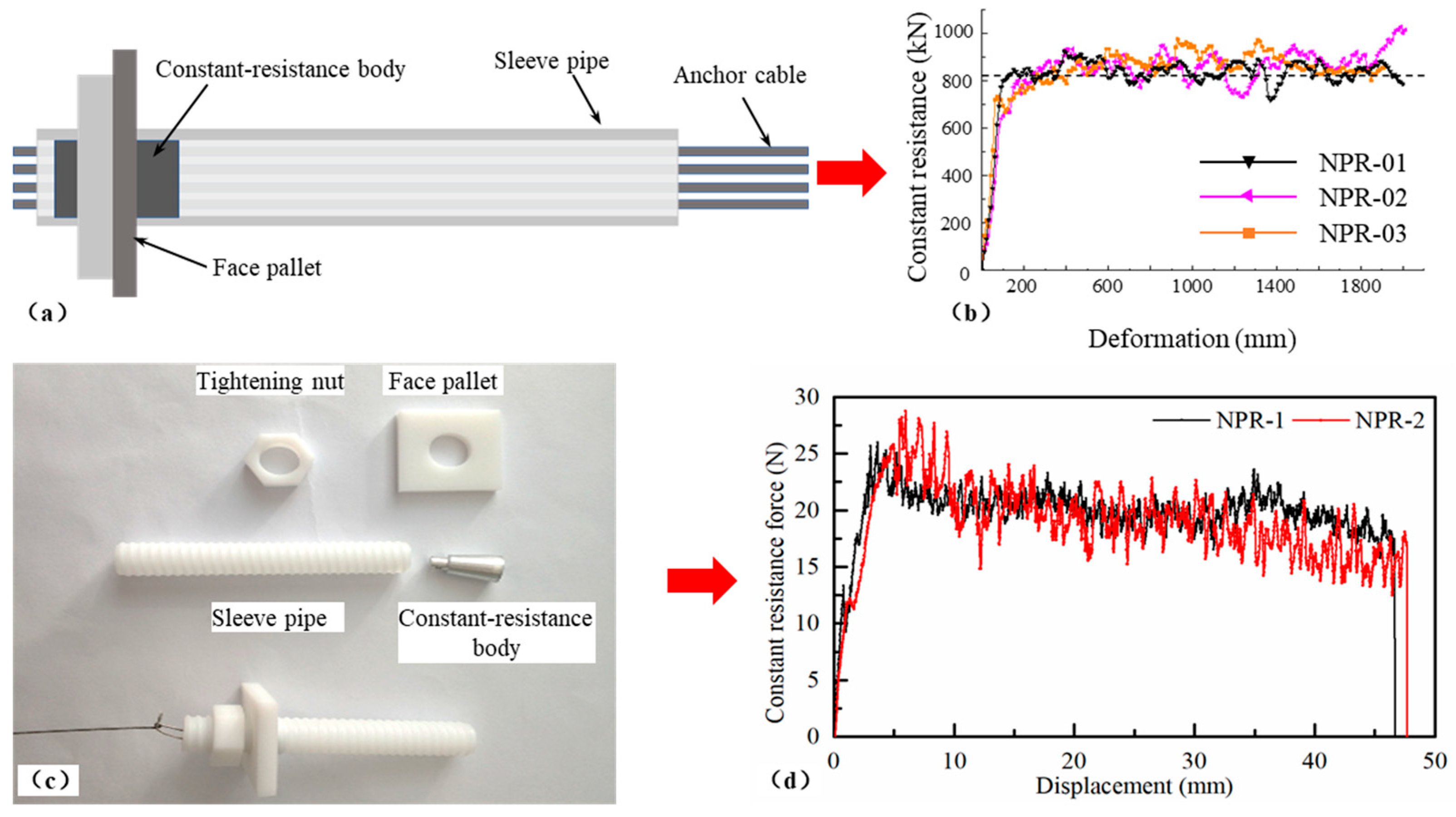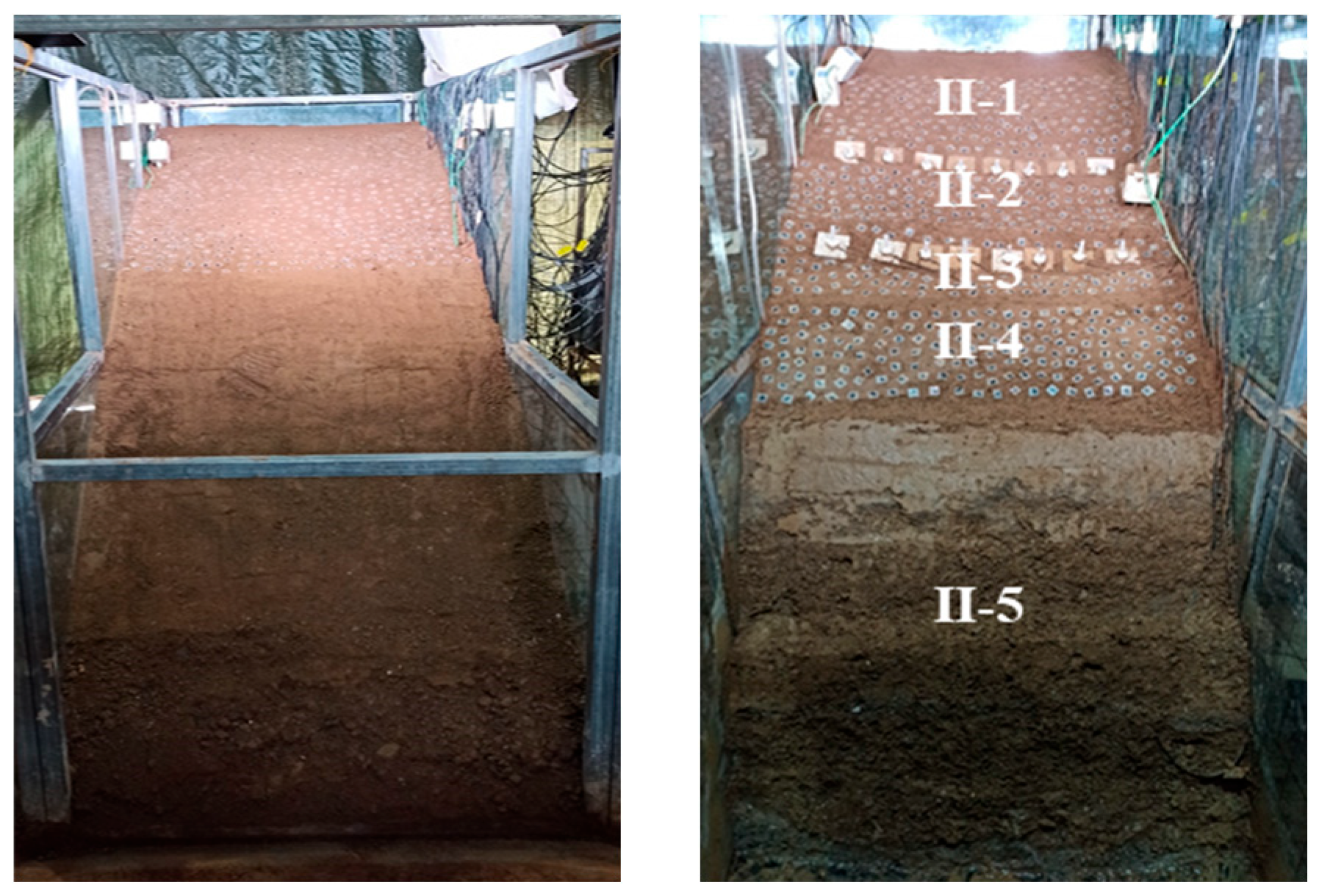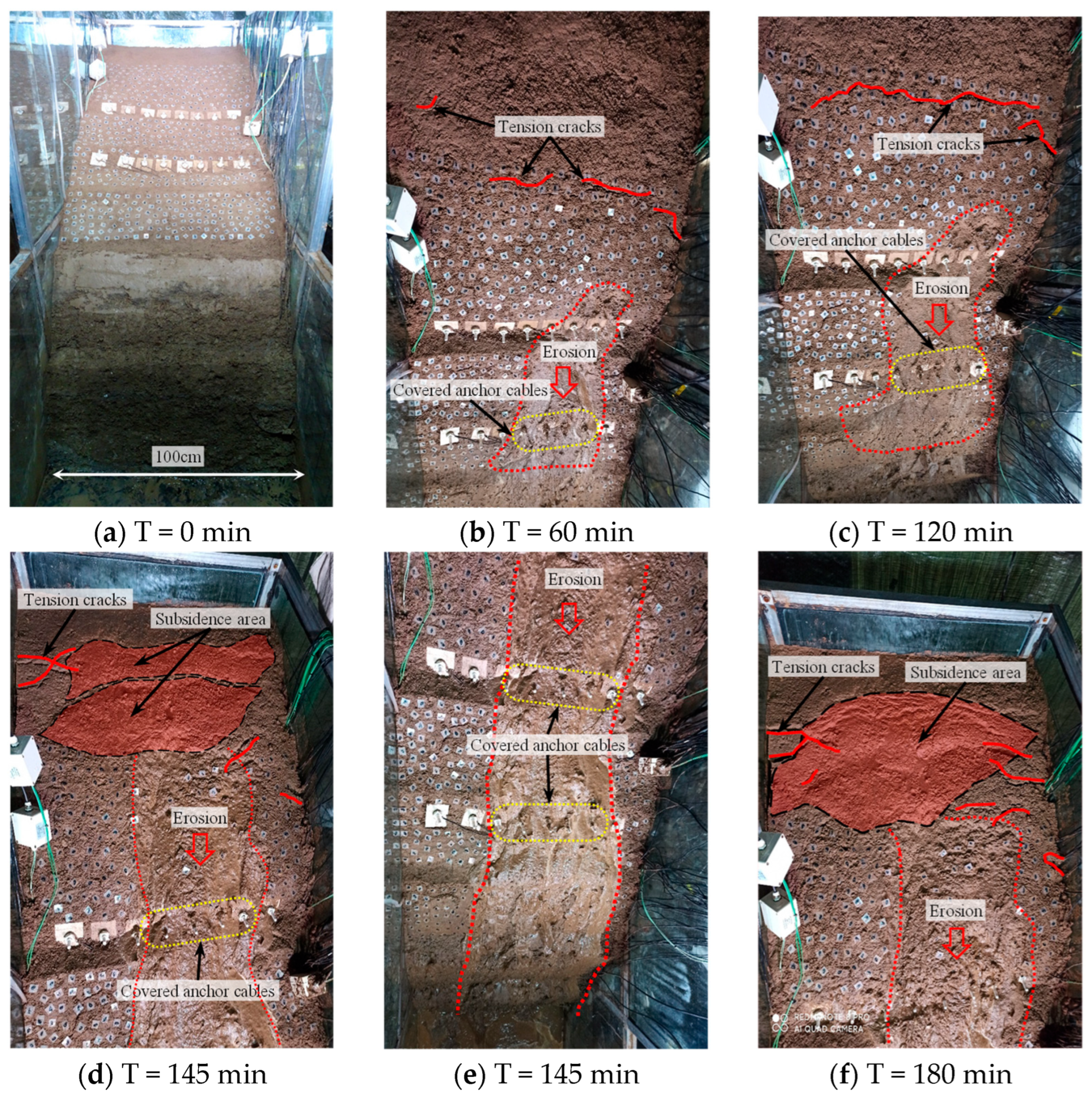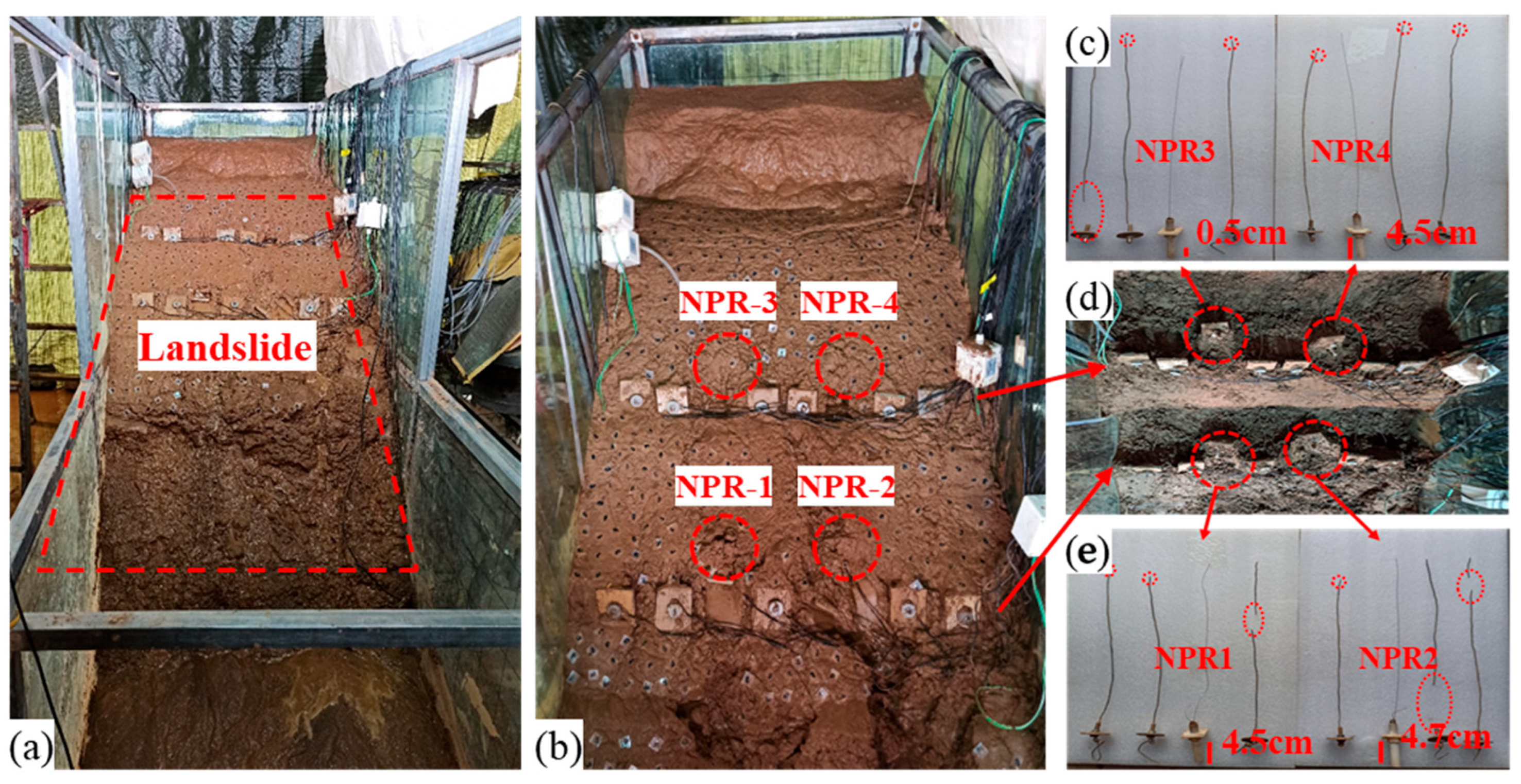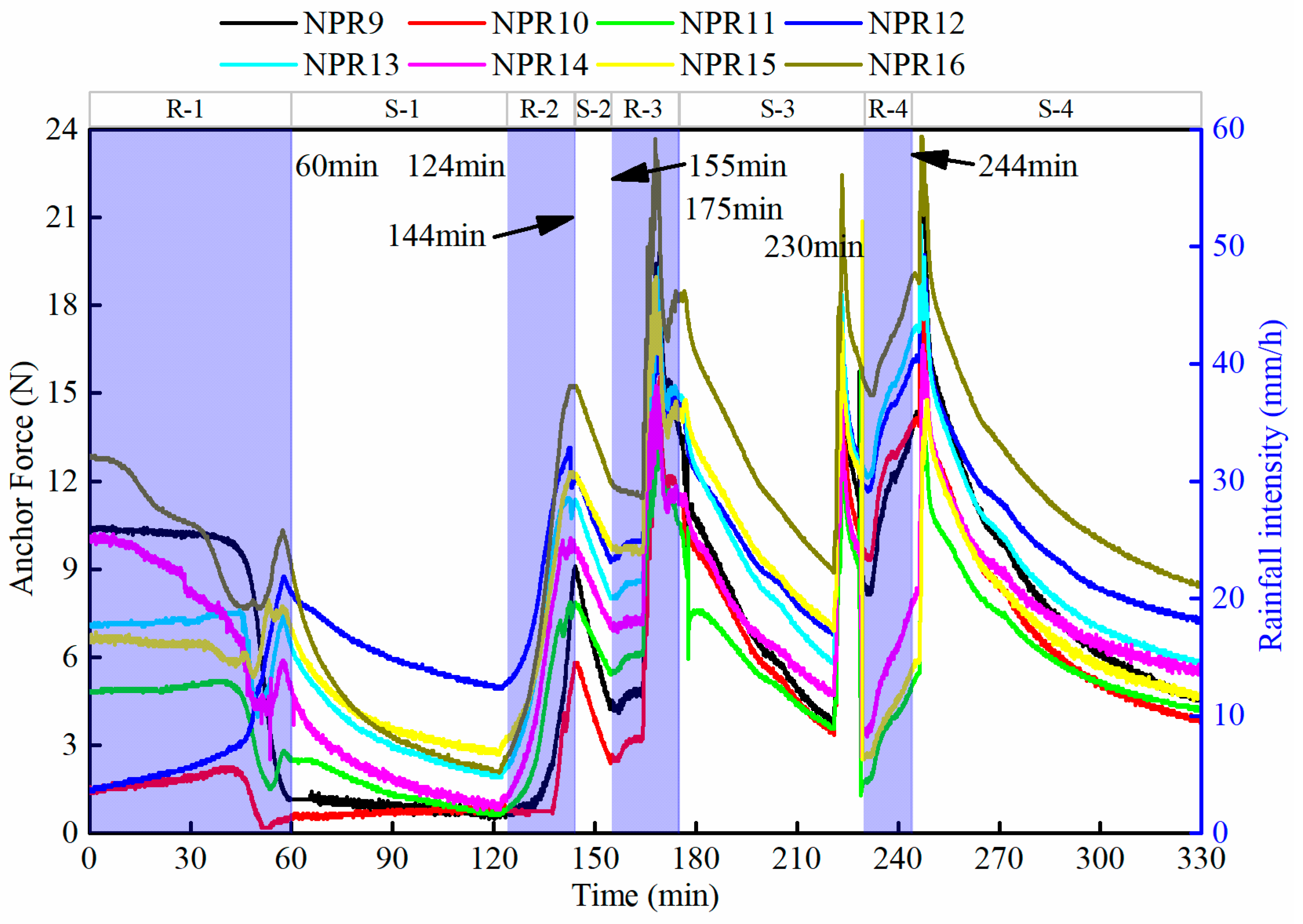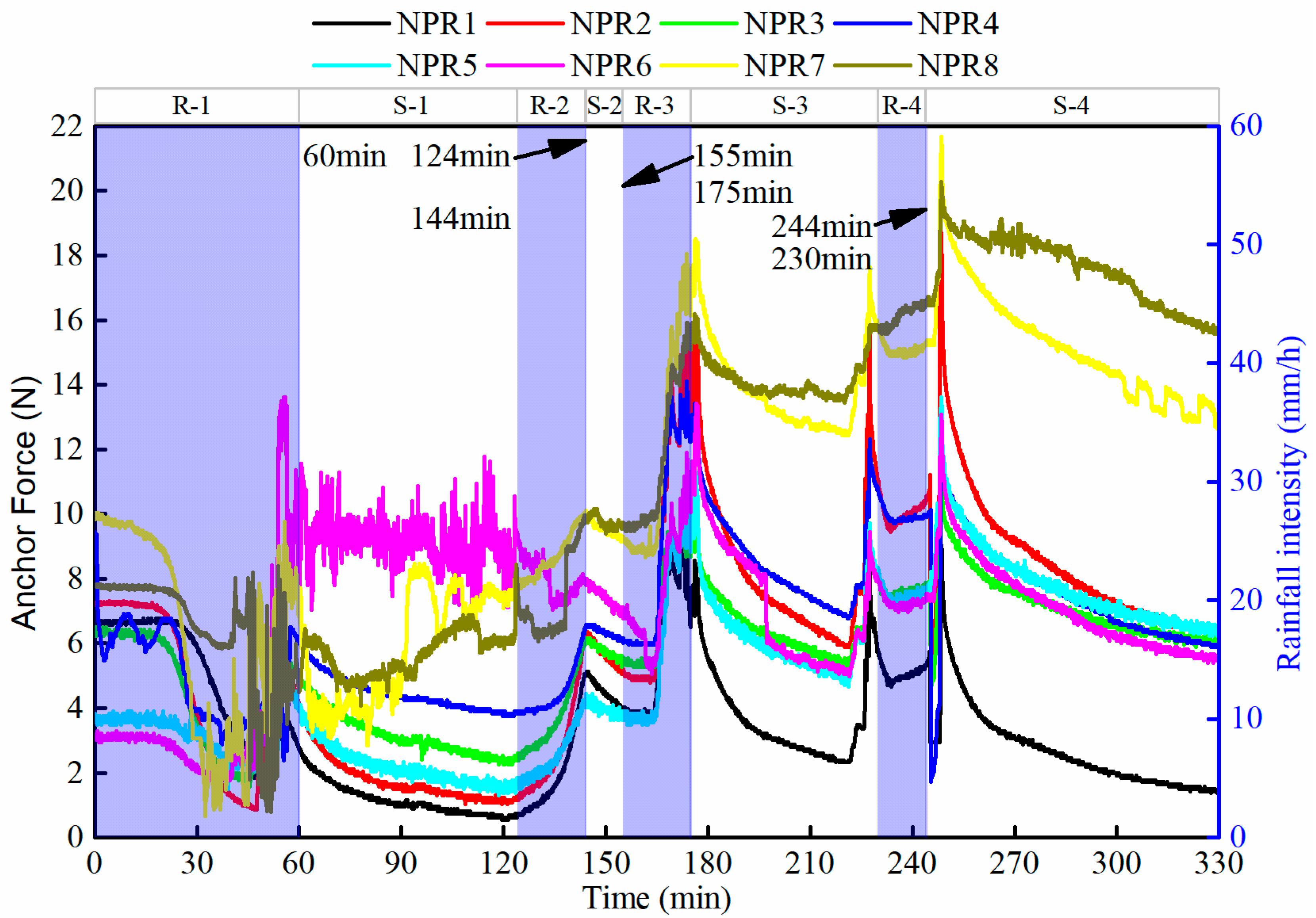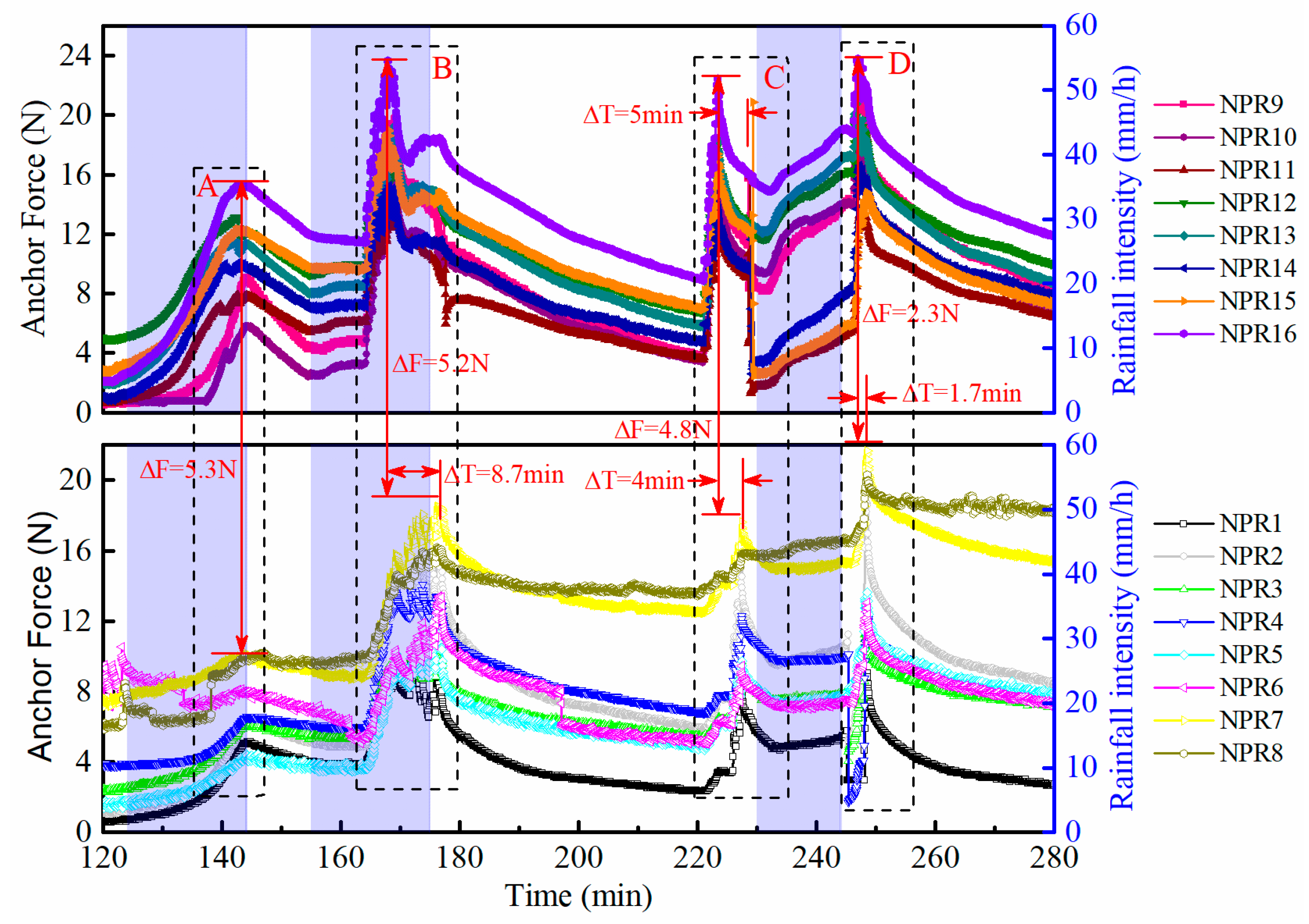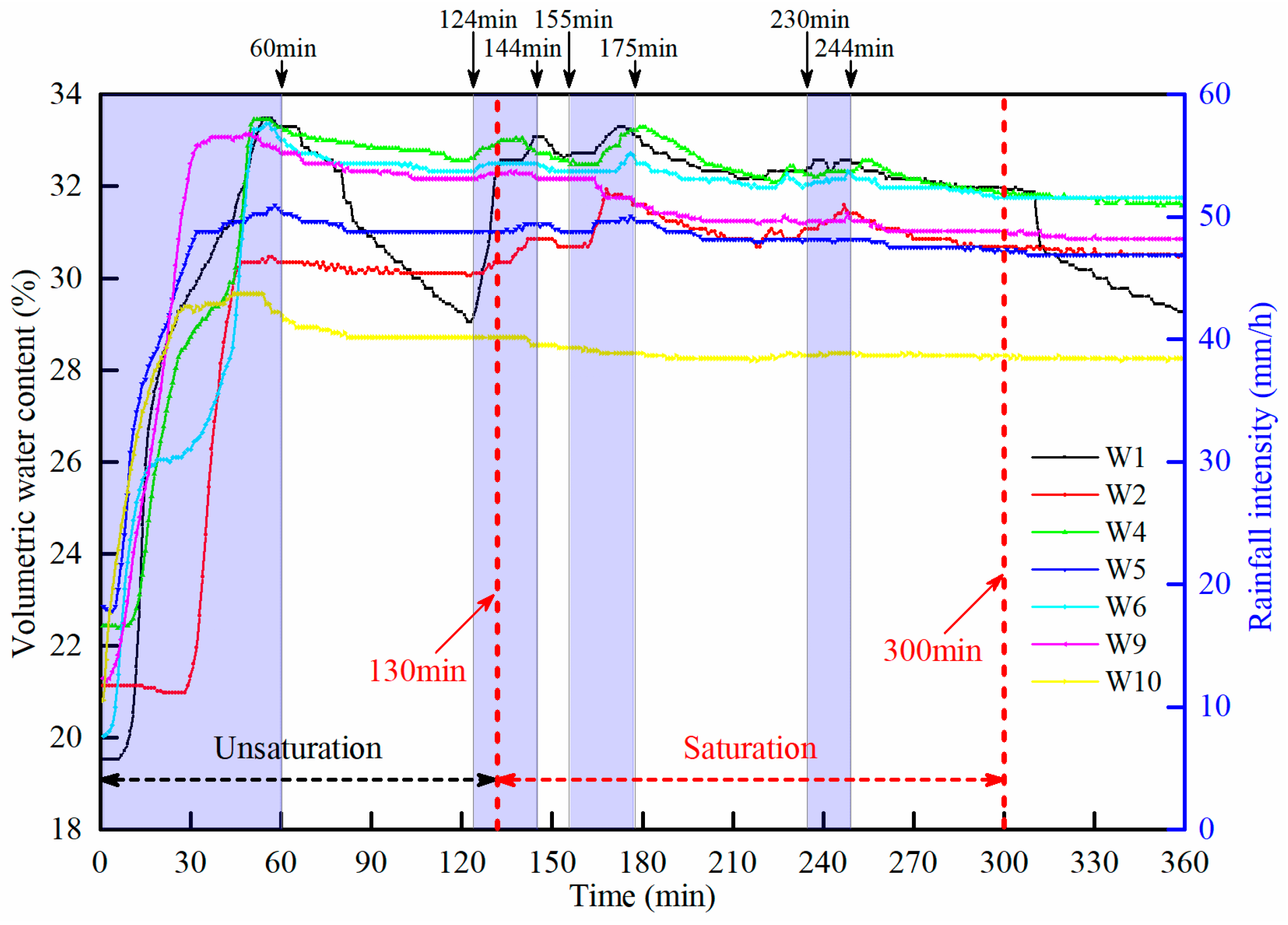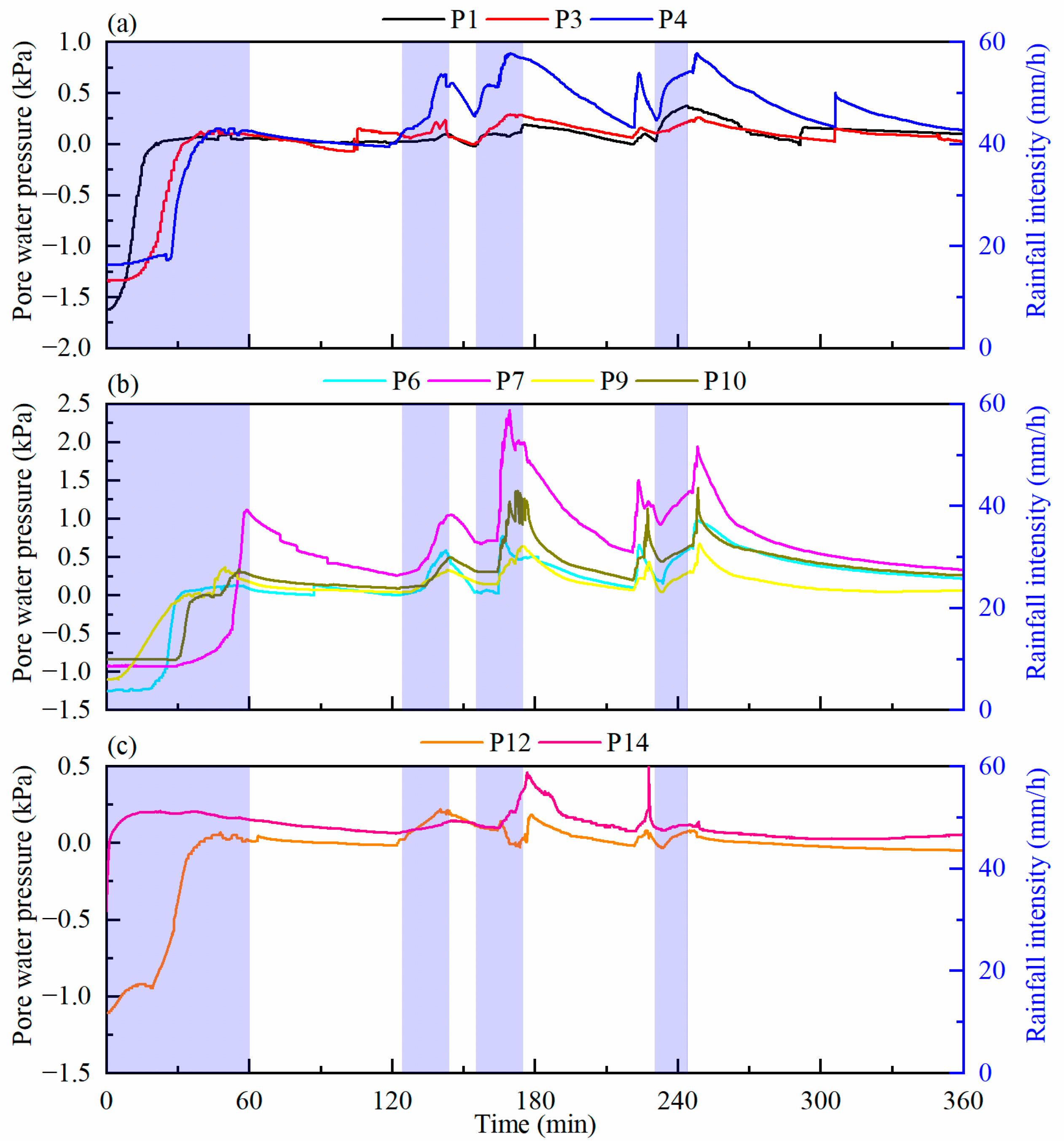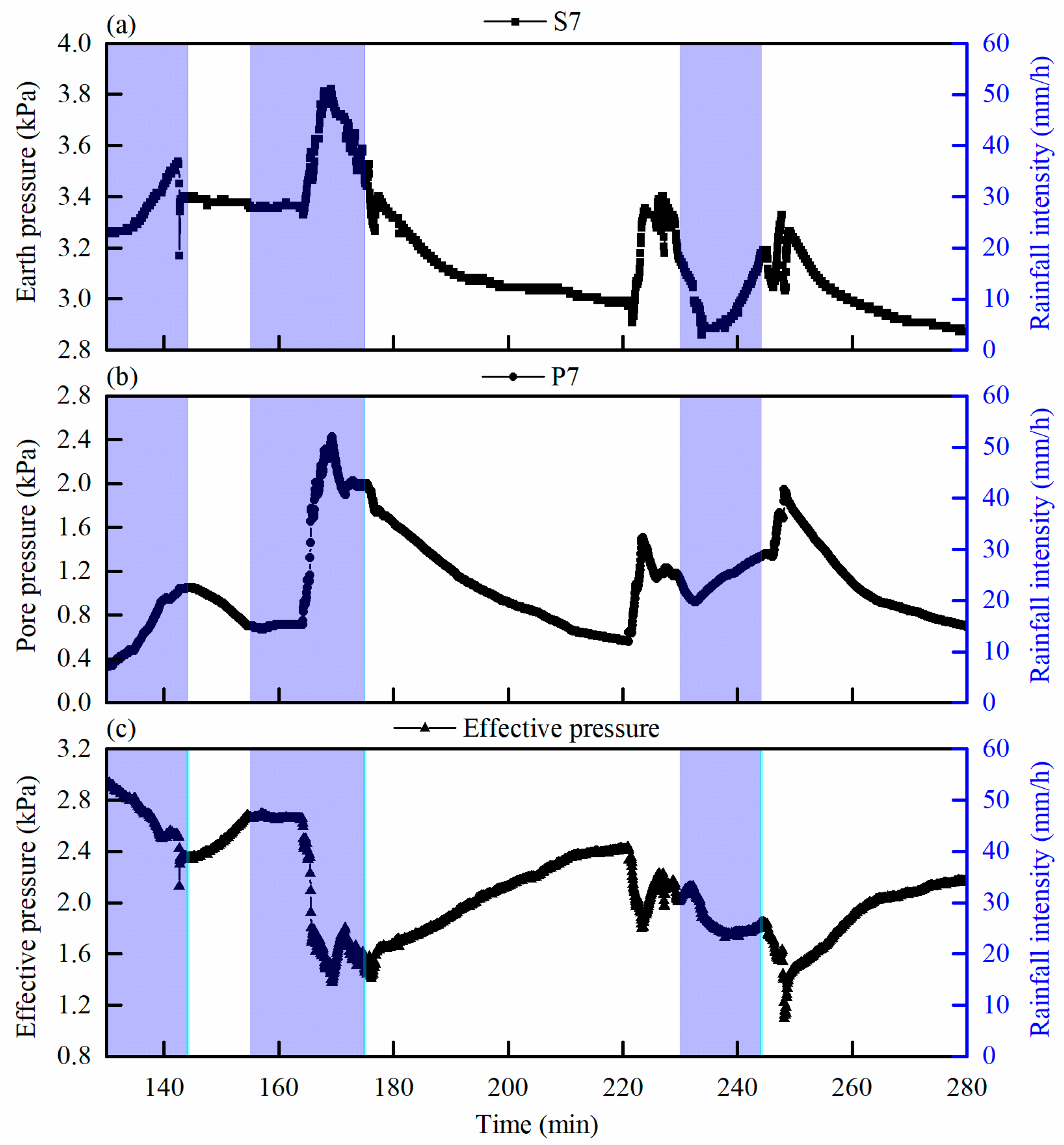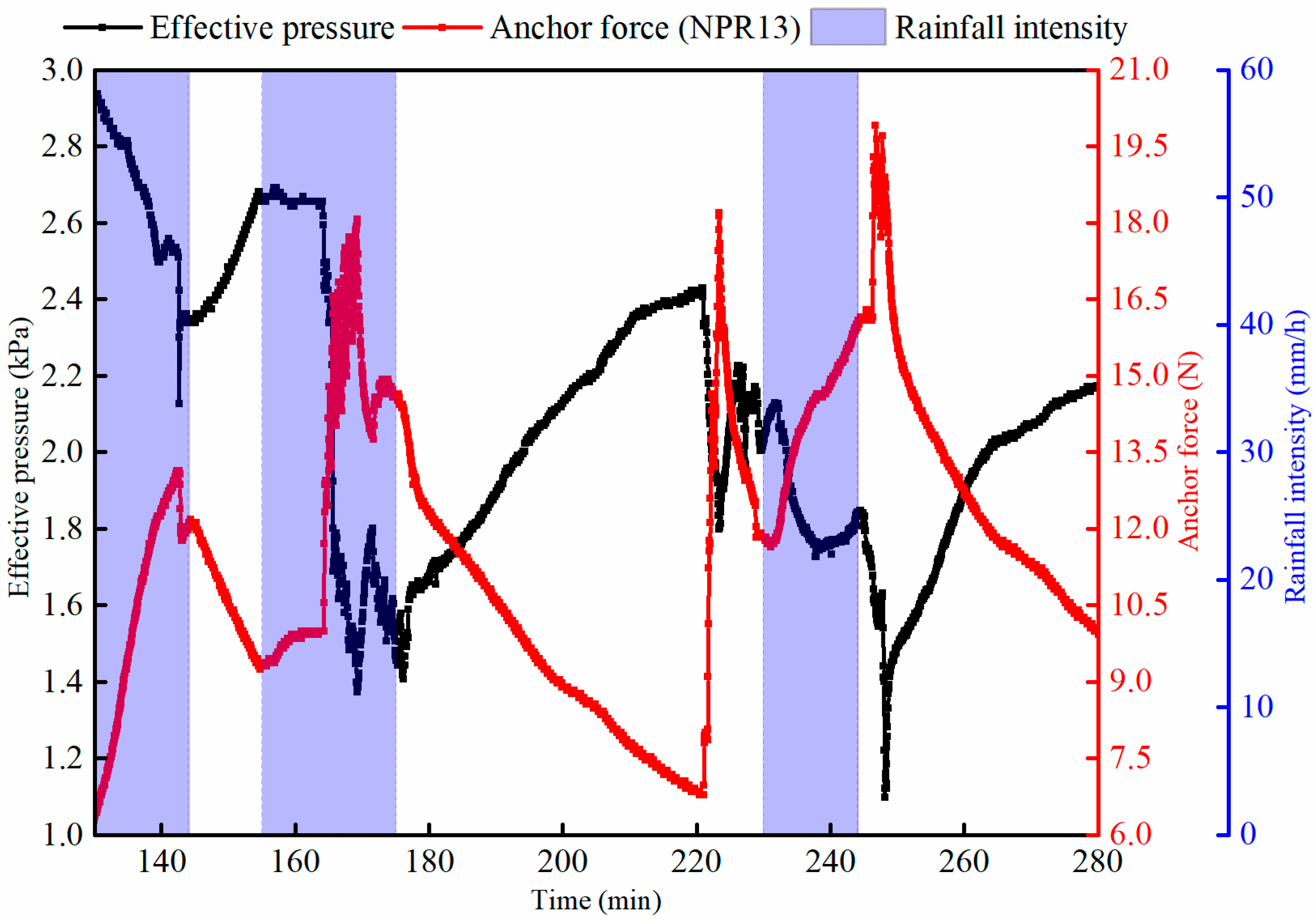1. Introduction
Rainfall-induced landslides are a pervasive global hazard, extensively documented in scientific literature, causing significant loss of life and substantial economic damage annually, including the destruction of buildings, roads, and critical infrastructure [
1,
2,
3,
4,
5]. These events are particularly prevalent in mountainous regions characterized by steep slopes, fractured geological formations, and heavy precipitation, such as Southwest China, where landslides frequently threaten building clusters in hillside communities [
6,
7,
8]. Rainfall infiltration into soil and rock layers elevates pore water pressure, reduces shear strength, and destabilizes slopes through mechanisms such as surface runoff erosion and groundwater saturation [
9,
10]. Empirical studies estimate that over 60% of landslides worldwide are triggered by prolonged or intense rainfall, with annual economic losses exceeding USD 4 billion—much of which stems from building collapses and infrastructure repairs [
11]. The increasing frequency and intensity of extreme precipitation events, driven by climate change, further exacerbate these risks, underscoring the urgent need for advanced mitigation and monitoring strategies to protect vulnerable buildings.
To mitigate landslide damage to buildings and surrounding infrastructure, scholars and engineers have developed a variety of control and mitigation measures. For instance, drainage systems and ecological engineering techniques, such as vegetation planting and bioengineering methods like geogrids, are employed to reduce surface water infiltration [
12,
13,
14,
15]. These approaches, combined with the rational design of surface drainage channels and subsurface drainage facilities, help prevent the increase in pore water pressure within slopes, thereby reducing landslide risks [
16,
17,
18]. However, these methods have limitations, including the need for regular maintenance and reduced effectiveness during extreme rainfall events. Consequently, additional structural measures such as anti-slide piles [
19], retaining walls [
20], and prestressed anchor cables [
21] are critical for building protection in high-risk zones. These measures effectively enhance slope stability by increasing sliding resistance, counteracting the destabilizing effects of rainfall, and compensating for the reduction in shear strength along potential sliding surfaces, thereby preventing catastrophic failures [
22]. Among these measures, anti-slide piles are reinforced concrete structures embedded into stable strata to resist sliding forces. They function by transferring loads from unstable soil layers to deeper, more stable geological formations. While highly effective for large-scale landslides, their implementation requires precise geotechnical analysis and is often associated with high installation costs [
23,
24]. Retaining walls, including gravity and cantilever types, stabilize slopes by counteracting lateral earth pressures. They are widely utilized due to their immediate stabilization effects; however, their performance can be compromised under extreme hydrological conditions, such as prolonged heavy rainfall, and they are generally unsuitable for addressing deep-seated instabilities [
25]. Prestressed anchor cables, on the other hand, compresses the rock mass through the tension cable, strengthens the integrity of the rock mass, enhances the anti-sliding force of the slope, and thus improves the stability of the slope [
26]. Although adaptable to complex terrains, the conventional prestressed anchor cable cannot withstand large slope deformation, which can easily cause damage under excessive deformation, so it is often necessary to use a variety of supporting measures together or improve the conventional prestressed anchor cable [
27,
28,
29,
30].
To address the technical limitations associated with the small deformation capacity of traditional anchor cable materials, Chinese researchers have pioneered the development of the negative Poisson ratio structural anchor cable, referred to as NPR anchor cable [
31,
32]. This innovative system integrates conventional anchor cables with a constant resistance large deformation device that exhibits a negative Poisson’s ratio structural effect. The system operates by utilizing the elastic deformation phase of the anchor cable until the stress reaches a predetermined constant resistance threshold. Upon reaching this threshold, the cable maintains a constant resistance value while the large deformation device undergoes significant displacement ranging from 0.5 to 3 m, simultaneously dissipating substantial energy through the deformation process [
33,
34]. Its adaptability makes it ideal for protecting buildings in deformation-prone areas [
35,
36]. Specifically, by accommodating slope deformation and absorbing landslide energy, the system facilitates secondary equilibrium of the slope without catastrophic failure [
37]. Furthermore, the anchor cable system enables continuous monitoring of internal mechanical information throughout the landslide process, thereby providing novel insights for landslide prediction [
38].
However, no comprehensive studies have been reported on the mutual feedback mechanism between NPR anchor cable force and slope internal stress during rainfall-induced landslide processes. This study employs artificial rainfall physical model tests to investigate slope deformation characteristics and the evolution of NPR anchor force under NPR cable reinforcement. By analyzing variations in volumetric water content, earth pressure, and pore water pressure during rainfall events, the research examines the relationship between NPR anchor cable force and effective stress under saturated conditions, thereby elucidating the control mechanism of NPR anchor cables in rainfall-induced landslides.
2. Experimental Design and Setup
Herein, an experimental method of controlling characteristics of NPR anchor cable for rainfall induced landslide is proposed, which includes experimental platform, physical model and material, monitoring system and experimental process.
2.1. Experimental Platform
The experimental platform is composed of the model experiment frame and artificial rainfall system (
Figure 1).
The experiment platform frame is constructed as a rigid-frame model box with dimensions of 3.2 m (length) × 2 m (height) × 1 m (width). To facilitate real-time observation and monitoring of the slope behavior during experiments, the side and rear boundaries of the model box are constructed using 10 cm thick transparent tempered glass. This design ensures both structural stability and visual accessibility.
The artificial rainfall simulation system is composed of five key elements: a rainfall frame, rainfall nozzles, a water pump, a flowmeter, and water supply equipment. The system has a separate water supply line equipped with 28 staggered sprinkler heads. This configuration ensures uniform rainfall distribution across the entire slope surface, enabling accurate simulation of natural rainfall conditions. The system is designed to precisely control rainfall intensity and duration, which are critical parameters for studying rainfall-induced slope failures. Through adjustment and testing, the rainfall intensity of the experiment is determined to be 60 mm/h.
2.2. Model Experimental Material
To accurately simulate the rainfall-induced landslide process and investigate the control characteristics of NPR (Negative Poisson’s Ratio) anchor cables, the slope model was systematically generalized into three distinct geological strata: the slide body, slide bed, and bedrock. Under the premise of maintaining model test validity, carefully selected similar materials were employed to construct each stratigraphic unit of the slope model, ensuring appropriate geomechanical representation of the sliding body, sliding bed, and bedrock. The materials were prepared using specific mass ratios of barite powder, sand, loess, gypsum powder, and water, with proportions of 1.7:3.5:0.5:1 for the sliding body, 3.8:2.3:1.3:1 for the sliding bed, and 4.2:1.8:2:1 for the bedrock, respectively. The physical and mechanical properties of these materials are summarized in
Table 1 [
37].
The engineering-scale NPR anchor cable, depicted in
Figure 2a, comprises a constant-resistance body, a sleeve pipe, a face pallet, and anchor cables, with a designed constant resistance force of 850 kN (
Figure 2b). To accurately replicate the structural behavior of the NPR anchor cable in laboratory conditions, a geometrically scaled-down model was fabricated, incorporating a constant-resistance body, a sleeve pipe, a face pallet, and a fastening nut (
Figure 2c). The constant-resistance body was fabricated from high-strength alloy, whereas the sleeve pipe was 3D-printed using flexible rubber to maintain optimal mechanical performance under large-strain conditions. Calibration tests confirmed that the model-scale NPR anchor cable exhibits a constant resistance of approximately 22 N (
Figure 2d). The detailed structural configuration and key mechanical parameters of the NPR anchor cable are summarized in
Table 2. This design enables the NPR anchor cable to effectively accommodate large deformations and dissipate energy, which is critical for simulating and controlling landslide dynamics under rainfall conditions.
2.3. Monitoring Instrument Layout
To comprehensively investigate the hydro-mechanical response of rainfall-induced landslides, a sophisticated instrumentation system was employed to monitor key parameters including volumetric water content, pore water pressure, earth pressure, and slope deformation. High-precision sensors were strategically deployed: volumetric water content was measured using sensors with an accuracy of ±3% VWC, pore water pressure was monitored with YSV-3201 sensors (accuracy: 0.05 kPa, Manufacturer: Beijing Yiyang Strain and Vibration Testing Technology Co., Ltd., Beijing, China), and earth pressure was recorded via YSV-3211 sensors (accuracy: 0.05 kPa). Slope deformation was captured using high-speed photography. Furthermore, JHBM-500N micro anchor cable dynamometers (accuracy: 0.05 N) were installed to track the force variation in NPR (Negative Poisson’s Ratio) anchor cables during slope reinforcement under rainfall conditions.
Figure 3 presents the detailed sensor arrangement and the initial configuration of the model slope prior to testing.
2.4. Experimental Process
The slope was excavated sequentially from top to bottom in five discrete stages, resulting in the formation of six benches, with the final stage comprising two benches. After each excavation step, the slope was allowed to stabilize for 30 min to ensure stress redistribution. The final excavated slope geometry is illustrated in
Figure 4. During the excavation process, two rows of NPR anchor cables were installed for reinforcement, positioned on the first and third benches, totaling 16 cables. Each NPR anchor cable was installed and prestressed immediately following the completion of the corresponding bench excavation to provide timely slope support.
The experimental procedure consisted of four sequential rainfall events. After each rainfall event, a designated standing period was implemented to ensure proper infiltration and equilibrium of the system. The detailed duration of rainfall and resting time are shown in
Table 3.
3. Deformation Characteristics Analysis of Model Slope
The deformation behavior of the slope under rainfall infiltration is illustrated in
Figure 5. Slope excavation-induced unloading effects result in severe erosion in the midslope region during rainfall, with the erosion-affected zone progressively expanding as rainfall persists.
Following the initiation of the R-1 rainfall event, tension cracks developed at the slope shoulder and top platform within approximately 60 min. During the S-1 process, the crack at the slope shoulder exhibited progressive expansion and eventual penetration. Subsequent R-2 rainfall led to the closure of these cracks, accompanied by minor uniform settlement deformation across the entire slope. Additionally, gentle slope deformation and secondary cracks formed on the top platform. Concurrently, rainfall-induced surface erosion extended toward the upper slope margin, and multiple anchor cables were inundated by erosional mudflow deposits.
After three additional rainfall episodes (cumulative duration: 54 min), no significant large-scale slope deformation was observed. However, slight settlement (approximately 1.5 cm) was detected on the slope top platform, accompanied by the development of localized tensile cracks along its peripheral zones.
Figure 6 illustrates the slope failure characteristics under identical conditions of combined support utilizing four NPR cables and twelve conventional prestressed cables [
37]. The experimental results demonstrate that all conventional prestressed anchor cables experienced failure, whereas the four NPR anchor cables exhibited significant deformation and energy-absorption capabilities during landslide occurrence, enabling the slope to attain a secondary stable state. In this study, replacing the twelve conventional prestressed anchor cables with NPR anchor cables resulted in only minor slope settlement, without inducing large-scale deformation or failure characteristics comparable to those observed with conventional support systems. This comparative analysis highlights the distinct advantages of NPR anchor cables in mitigating rainfall-induced landslide disasters. However, the mechanistic interaction between NPR cable forces and slope internal forces in maintaining slope stability remains unclear and warrants further investigation.
4. Mechanical Behavior of NPR Anchor Cable
Figure 7 and
Figure 8 depict the axial force evolution curves for the upper and lower NPR anchor cables, respectively. Owing to the constraints imposed by the dimensions of the model box, the initial prestress levels of the NPR anchor cables exhibit variability.
4.1. Mechanical Behavior of Axial Forces in Upper NPR Anchor Cables
The monitoring curves of the upper NPR anchor cables indicate that during the R-1, the cable forces initially remain at their prestress levels before undergoing a gradual decline (
Figure 7). Approximately 45 min after rainfall initiation, the cable forces exhibit fluctuating increases, with the amplitude and duration of these fluctuations being significantly more pronounced in the lower-row cables compared to the upper-row cables. This behavior can be attributed to the following factors: (1) variability in initial prestress among the anchor cables, (2) formation of an unloading relaxation zone due to slope excavation (3) slope consolidation and deformation induced by rainwater infiltration, and (4) greater mechanical sensitivity of the lower-row cables to the combined influence of the upper slope and upper-row cables. In essence, this phenomenon reflects a dynamic stress redistribution process, wherein the anchor cable forces and internal slope stresses undergo mutual adaptation.
During the S-1 stage, the NPR anchor cable forces exhibit a two-phase response: an initial rapid reduction, followed by a more gradual decline. From the onset of R-2 rainfall until approximately 15 min into the event, all anchor cables—except NPR9 and NPR16—display minor, abrupt force fluctuations, suggesting localized internal slope deformations. In the subsequent standing stage (post-rainfall), the cable forces decrease at a near-constant rate, indicative of progressive stress relaxation.
Approximately 10 min after R-3 rainfall initiation, the cable forces undergo a slow increase, followed by a linear sudden surge, and drop (slope ≈ 1), and subsequently exhibit wave-like fluctuations. This pattern suggests the occurrence of significant deformation in the middle and upper slope regions. Except for NPR11, which experiences an immediate force drop at the S-3 onset, all other cables demonstrate a steady force reduction rate, implying localized shear penetration within the slope zone controlled by NPR11. After 45 min into S-3, all cable forces exhibit a sharp increase and subsequent drop (slope ≈ 1), signaling a secondary large-scale slide in the middle-upper slope. At the beginning of the R-4, the cable forces of NPR11, NPR14, and NPR15 undergo a significant abrupt drop. Following the cessation of R-4 rainfall, the NPR cable forces experience a third abrupt increase, succeeded by a sharp decline. This sequence highlights the complex coupling mechanism between rainfall infiltration, slope deformation, and cable force evolution, underscoring the progressive nature of slope instability under cyclic hydrological loading.
4.2. Mechanical Behavior of Axial Forces in Lower NPR Anchor Cable
During the S-1 stage, most cables exhibited gradual force reduction, except for NPR6, which remained constant with fluctuations, and NPR7 and NPR8, which showed a fluctuating upward trend after an initial drop (
Figure 8). Notably, NPR7 surged abruptly at 30 min into R-2, followed by gradual increase, while NPR8 maintained steady growth with a minor drop at 50 min. These phenomena can be attributed to (1) heterogeneous slope deformation, and (2) localized deformation propagation within NPR7 and NPR8 controlled zones.
In the R-2 stage, NPR anchor cable forces, excluding NPR6 and NPR8, progressed through three stages: initial stability, slow increase, and rapid surge (
Figure 8). NPR8 displayed a secondary drop at 5 min and a surge at 15 min before rapid escalation, whereas NPR6 declined slowly, dropped sharply at 10 min, then rose sluggishly. This behavior is primarily due to (1) the relatively stable slope region reinforced by the NPR1-NPR5 cables, and (2) further deformation and propagation within the slope area controlled by the NPR6-NPR8 cables, indicating spatially evolving slope failure.
During the initial R-3 stage, cable forces remained stable except for NPR6 and NPR7, which showed minor reductions. A marked force increase occurred in all cables after 10 min of rainfall, followed by 3 min of sustained growth before transitioning to upward-trending fluctuations. This behavior reflects (1) rainfall-induced hydrostatic pressure increasing slope driving forces while reducing shear resistance along potential slip surfaces, and (2) progressive internal deformation coupled with surface erosion-induced soil loss.
The S-3 commenced with a sharp force spike followed by progressive decay. Abrupt force reduction in NPR6 indicated localized shear failure. During R-6, all cables exhibited secondary force surges at 50 min, followed by rapid decline (except stable NPR8). This suggests that a large-scale slip occurred within the slope, although no significant surface deformation was observed.
In the R-4 stage, initial force reduction reversed after 5 min. However, extensive surface erosion compromised slope integrity and monitoring reliability, prompting rainfall termination at 14 min. Approximately 5 min after the rainfall ceased, the cable forces experienced varying degrees of sudden increase again. This indicates that the slope had begun to slide, but due to the energy-absorbing characteristics of the NPR cables, no large-scale deformation or failure occurred.
4.3. Force Comparison Between Dual Rows of NPR Anchor Cables
Figure 9 presents a comparative analysis of the force curves for the upper and lower rows of NPR anchor cables. The four regions labeled A, B, C, and D correspond to key time intervals during which the anchor cable forces exhibited significant increases. The comparative analysis reveals the following:
(1) The rate of force increase in the upper row of cables was significantly higher than that in the lower row.
(2) The peak tensile force in the upper anchor cable is significantly higher than that in the lower cable, with the force difference gradually diminishing as slope deformation progresses. Specifically, the maximum inter-cable force difference decreases sequentially from 5.3 N (Zone A) to 5.2 N (Zone B), 4.8 N (Zone C), and finally 2.3 N (Zone D), indicating a consistent weakening trend in cable load disparity with increasing slope displacement.
(3) After reaching their peak values, the forces in the upper row cables often experienced a pronounced sudden drop, with the magnitude of this drop being significantly larger than that observed in the lower row.
(4) The sudden stress increase in the upper row of cables occurs earlier than that in the lower row, with the time difference between their peak stresses gradually decreasing. From Zone B to Zone D, the observed time differences are 8.7 min, 4 min, and 1.7 min, respectively. This trend suggests that the potential sliding surface within the slope progressively develops toward full penetration.
These observations indicate that the slope underwent a deformation process that transitioned from localized to more extensive areas, with both deformation and slip events exhibiting a spatial progression from the upper to the lower sections of the slope.
The evolution of the NPR anchor cable forces suggests that the slope experienced internal slips that progressed from localized to more extensive areas. However, based on the deformation characteristics of the slope, it is evident that while minor slips occurred, the slope did not undergo large-scale deformation or instability. Only two minor steps were observed at the upper edge of the slope. This demonstrates that, despite multiple internal slip events, the NPR anchor cables effectively absorbed the energy generated by these movements, underscoring their significant energy-absorbing and slope-stabilizing capabilities.
5. Variation in Monitoring Parameters Responding to Rainfall
5.1. Evolution Characteristics of Volumetric Water Content
The change in volume water content at different depths of the slope during rainfall infiltration is shown in
Figure 10. The W10, W9, W6, and W5 volumetric moisture content sensors, installed beneath the slope excavation platform, exhibited sequential responses to rainwater infiltration. The response time of W1, W4, and W2 sensors located below the inclined slope at the upper edge of the slope is relatively late. The W2 sensor, due to its greater buried depth, changes after 28 min of rainfall. All sensors reached their peak moisture content values following 50 min of continuous rainfall. A significant observation was the rapid decrease in W1′s moisture content from 33.48% to 29.04% after the initial rainfall event. This phenomenon can be attributed to the formation of tension cracks at the slope shoulder, which facilitated accelerated drainage and consequent moisture content reduction. During the subsequent rainfall event, the moisture content at W1 increased rapidly to its maximum value. Particularly after 130 min, all sensors maintained relatively stable moisture readings, indicating that the slope had reached a saturated state.
5.2. Evolution Characteristics of Earth Pressure
Figure 11 illustrates the evolution of earth pressure under continuous rainfall conditions. The earth pressure measured at SP6, SP9, SP12, and SP14, positioned on the upper section of the slope, exhibits a decreasing trend due to the erosive impact of rainfall on the slope surface. Notably, at T = 144 min, a significant and abrupt reduction in earth pressure is observed at SP6, with a maximum drop of 0.8 kPa. This abrupt change is attributed to the minor settlement amplitude of the slope, with SP6 being uniquely situated at the upper part of the reinforced slope. Subsequent observations at T = 165 min, T = 220 min, and T = 245 min reveal varying degrees of sudden increases and decreases in earth pressure. These fluctuations, when correlated with the NPR anchor cable monitoring data, suggest the occurrence of localized deformations within the slope. These deformations are evidenced by the development of settlement and tension cracks at the slope’s crest, underscoring the progressive nature of slope deformation from localized areas to a more extensive scale. This gradual process highlights the dynamic response of the slope to continuous rainfall and the effectiveness of the reinforcement measures in mitigating slope instability.
5.3. Evolution Characteristics of Pore Water Pressure
As depicted in
Figure 12, the pore water pressure monitoring curves exhibit a generally consistent trend, with localized variations observed at specific time intervals. Notably, at T = 165 min, the pore water pressure at PP4, PP7, and PP10 demonstrates abrupt changes and fluctuations. Subsequently, at T = 215 min and T = 245 min, a sudden increase in pore water pressure is recorded at PP4, PP6, PP7, PP9, PP10, and PP14. These abrupt changes, when analyzed in conjunction with the corresponding cable force data, indicate localized sliding and expansion within the slope. This deformation is primarily concentrated near the interface of the two strata, leading to the observed sudden increase in pore water pressure. Furthermore, the PP12 and PP14 sensors, situated at the lower section of the slope, exhibit a delayed response compared to those located in the upper section. This temporal delay suggests that the deformation within the slope initiates at the upper edge and progressively propagates downward toward the lower edge.
6. Mutual Feedback Mechanism Between NPR Anchor Cable Force and Effective Stress
As illustrated in
Figure 10, the monitoring area of the model slope achieved full saturation after 130 min of continuous rainfall infiltration. To elucidate the dynamic interaction between slope stress redistribution and NPR anchor cable behavior, a detailed analysis was conducted on the earth pressure at monitoring point S7 and the pore water pressure at P7, both positioned in close proximity to the anchor cables. The earth pressure sensor recorded the total vertical stress exerted by the overlying soil mass, while the effective stress evolution was determined by subtracting the pore water pressure from the measured earth pressure, adhering to Terzaghi’s effective stress principle (
Figure 13).
A comparative analysis of the effective stress evolution during the saturation phase and the corresponding NPR13 anchor cable force revealed a distinct inverse correlation. During the rainfall phase, the progressive saturation of the slope led to a continuous reduction in effective stress due to the increasing pore water pressure, which diminished the interparticle contact forces within the soil matrix. Concurrently, the NPR anchor cable force exhibited a marked increase (
Figure 14), suggesting that the cables actively compensated for the loss of shear resistance caused by the declining effective stress.
Following the cessation of rainfall, the effective stress gradually recovered as pore water pressure dissipated, allowing the soil skeleton to regain partial load-bearing capacity. This recovery phase was accompanied by a corresponding reduction in the NPR anchor cable force, indicating a stress transfer back to the slope matrix. Notably, abrupt fluctuations or stabilization in effective stress were mirrored by instantaneous adjustments in the anchor cable force, underscoring the real-time responsiveness of the NPR anchor cables to internal stress variations.
This phenomenon can be attributed to the unique structural properties of NPR anchor cables, which exhibit lateral expansion under tensile loading, thereby enhancing the reinforcement effect on the surrounding soil. This mechanism enables the cables to dynamically counteract stress redistributions induced by rainfall infiltration. Specifically, when effective stress diminishes due to rainfall, the NPR anchor cables engage in adaptive stress compensation, effectively redistributing the load and mitigating potential shear failure. Conversely, as the slope regains stability post-rainfall, the cables relax, reducing their load-bearing contribution.
This positive feedback mechanism ensures that the slope remains either in a stable equilibrium or undergoes only minimal deformation, even under prolonged rainfall conditions. The findings align with previous studies on NPR materials in geotechnical applications, further validating their efficacy in slope stabilization under hydrological conditions. At the same time, the experimental results highlight the potential of NPR anchor cables as an innovative reinforcement measure in rainfall-prone landslide areas.
7. Conclusions
The controlling effects of NPR anchor cables on slope stability under rainfall conditions is revealed by means of laboratory physical model test. The research results provide comprehensive insights into the evolutionary behavior of NPR anchor cable forces during rainfall, the stress redistribution within the slope, and the deformation characteristics of the slope surface. These findings offer valuable guidance for the prevention and mitigation of rainfall-induced landslides. The key conclusions are as follows:
(1) The upper-row anchor cables exhibit a significantly earlier response to rainfall-induced slope deformation compared to the lower-row cables. Additionally, the axial force variation in the upper-row cables is markedly greater than that in the lower-row cables. Notably, the difference in both response time and abrupt force changes diminishes over time. The results demonstrate that slope deformation propagates progressively from the upper to the lower sections, evolving from localized instability to a generalized failure mechanism.
(2) Under saturated conditions, the NPR anchor cable exhibits an adaptive stress compensation mechanism in response to variations in slope effective stress. Specifically, the axial force of the NPR anchor cable increases as the effective stress decreases and appropriately reduces when the effective stress rises. This self-adjusting compensation effect enables the NPR anchor cable to effectively accommodate internal stress fluctuations within the slope, thereby maintaining slope stability or limiting deformation to a minimal range during rainfall events.
(3) The novel structural configuration and exceptional mechanical properties of NPR anchor cables demonstrate remarkable efficacy in mitigating rainfall-induced landslide hazards. These advanced cable systems enable comprehensive monitoring of the entire landslide failure process, thereby offering innovative solutions and significant potential for enhancing landslide early warning systems. However, despite the successful application in landslide monitoring and numerous successful warning cases, there remains a significant research gap regarding the interaction mechanism between NPR anchor cables and slope internal stress, particularly in the context of rainfall-induced landslides.
Author Contributions
Conceptualization, G.S.; formal analysis, G.S.; data curation, G.S.; methodology, G.S. and F.Z.; resources, Z.T.; investigation, G.S., Z.T., F.Z., Z.X. and X.H.; writing—original draft, G.S.; supervision, X.Y.; validation, G.S., Z.T. and X.Y.; writing—review and editing, J.D.; funding acquisition, Z.T. and X.Y.; project administration, Z.T. and X.Y. All authors have read and agreed to the published version of the manuscript.
Funding
This research received no external funding.
Data Availability Statement
The original contributions presented in the study are included in the article, further inquiries can be directed to the corresponding author.
Conflicts of Interest
Author Zhouchao Xu was employed by the company Guizhou Datong Road and Bridge Engineering Construction Co., Ltd. The remaining authors declare that the research was conducted in the absence of any commercial or financial relationships that could be construed as a potential conflict of interest.
References
- Guzzetti, F.; Mondini, A.C.; Cardinali, M.; Fiorucci, F.; Santangelo, M.; Chang, K.T. Landslide inventory maps: New tools for an old problem. Earth-Sci. Rev. 2012, 112, 42–66. [Google Scholar] [CrossRef]
- Mondini, A.C.; Guzzetti, F.; Melillo, M. Deep learning forecast of rainfall-induced shallow landslides. Nat Commun. 2023, 14, 2466. [Google Scholar] [CrossRef] [PubMed]
- Petley, D.N. Global patterns of loss of life from landslides. Geology 2012, 40, 927–930. [Google Scholar] [CrossRef]
- Piciullo, L.; Calvello, M.; Cepeda, J.M. Territorial early warning systems for rainfall-induced landslides. Earth-Sci. Rev. 2018, 179, 228–247. [Google Scholar] [CrossRef]
- He, P.T.; Li, C.R.; Zheng, W. Shear Nonlinear Behavior of Rock Discontinuities with Different Joint Roughness Coefficients. Int. J. Geo-Energy 2023, 1. [Google Scholar] [CrossRef]
- Ju, N.; Huang, J.; He, C.; Van Asch, T.W.; Huang, R.; Fan, X.; Xu, Q.; Xiao, Y.; Wang, J. Landslide early warning, case studies from Southwest China. Eng. Geol. 2020, 279, 105917. [Google Scholar] [CrossRef]
- Zhang, S.; Xu, Q.; Hu, Z.M. Effects of rainwater softening on red mudstone of deep-seated landslide, Southwest China. Eng. Geol. 2016, 204, 1–13. [Google Scholar] [CrossRef]
- Tang, S.B.; Liu, F.S.; Zhu, C.; Chen, X.M.; Wang, X.Z.; Wang, Z.Z.; Chao, L.Y.; Su, Y.; Zhao, L.; Li, J.M.; et al. Study on Denoising Microseismic Signal Based on Autoencoder Convolutional Neural Networks. Int. J. Geo-Energy 2023, 1. [Google Scholar] [CrossRef]
- Crozier, M.J. Deciphering the effect of climate change on landslide activity: A review. Geomorphology 2010, 124, 260–267. [Google Scholar] [CrossRef]
- Dai, F.C.; Lee, C.F.; Ngai, Y.Y. Landslide risk assessment and management: An overview. Eng. Geol. 2002, 64, 65–87. [Google Scholar] [CrossRef]
- Froude, M.J.; Petley, D.N. Global fatal landslide occurrence from 2004 to 2016. Nat. Hazard. Earth Syst. 2018, 18, 2161–2181. [Google Scholar] [CrossRef]
- Liu, C.N.; Yang, K.H.; Ho, Y.H.; Chang, C.M. Lessons learned from three failures on a high steep geogrid-reinforced slope. Geotext. Geomembr. 2012, 34, 131–143. [Google Scholar] [CrossRef]
- Zou, X.W.; Zhou, T.; Li, G.; Hu, Y.; Deng, B.; Yang, T. Intelligent Inversion Analysis of Surrounding Rock Parameters and Deformation Characteristics of a Water Diversion Surge Shaft. Designs 2024, 8, 116. [Google Scholar] [CrossRef]
- Wei, B.N.; Huang, Q.X.; Cao, J. Research on Roof Structure Model and Reasonable Support of GSER by Cutting Roof in Three-Soft Coal Seam. Int. J. Geo-Energy 2023, 1. [Google Scholar] [CrossRef]
- Pepe, G.; Cevasco, A.; Piazza, M.; Macciò, R.; Arrighetti, F.; Casagli, N. On the efficiency and effectiveness of automatic deep drainage systems during an extreme rainfall event: The Mendatica landslide case study (western Liguria, Italy). Landslides 2021, 18, 3799–3820. [Google Scholar] [CrossRef]
- Sun, H.Y.; Pan, P.; Lü, Q.; Wei, Z.L.; Zhan, W. A case study of a rainfall-induced landslide involving weak interlayer and its treatment using the siphon drainage method. Bull. Eng. Geol. Environ. 2019, 78, 4063–4074. [Google Scholar] [CrossRef]
- Ma, W.B.; Zou, W.H.; Zhang, J.L.; Li, G. Prediction of Shear Strength in Anisotropic Structural Planes Considering Size Effects. Designs 2025, 9, 17. [Google Scholar] [CrossRef]
- Yan, L.; Xu, W.Y.; Wang, H.L.; Wang, R.B.; Meng, Q.X.; Yu, J.; Xie, W.C. Drainage controls on the Donglingxing landslide (China) induced by rainfall and fluctuation in reservoir water levels. Landslides 2019, 16, 1583–1593. [Google Scholar] [CrossRef]
- Luo, S.L.; Huang, D.; Peng, J.B.; Aierken, A.; Li, Z.; Kuang, X.B.; Tomás, R. Performance and application of a novel drainage anti-slide pile on accumulation landslide with a chair-like deposit-bedrock interface in the Three Gorges Reservoir area, China. Comput. Geotech. 2023, 155, 105199. [Google Scholar] [CrossRef]
- Li, Z.; Huang, D.; Liang, Y.G.; Song, Y.X. Control effect of a novel high-permeability counterfort retaining wall on rainfall-induced landslides. Environ. Earth Sci. 2025, 84, 96. [Google Scholar] [CrossRef]
- Zhang, J.J.; Niu, J.Y.; Fu, X.; Cao, L.C.; Yan, S.J. Failure modes of slope stabilized by frame beam with prestressed anchors. Eur. J. Environ. Civ. Eng. 2020, 26, 2120–2142. [Google Scholar] [CrossRef]
- Zhang, H.; Xing, H.F.; Zhu, L.; Tannant, D.; Guo, X.P. Centrifuge model tests of h-type anti-slide pile reinforced slope under different rainfall duration. Eur. J. Environ. Civ. Eng. 2024, 28, 3292–3312. [Google Scholar] [CrossRef]
- Huang, D.; Song, Y.X.; Li, Z.; Luo, S.L.; Peng, J.B.; Tomás, R. Working performance and mechanism of a novel upper-hollow drainage anti-slide pile under the effect of reservoir water fluctuation and precipitation. Acta Geotech. 2023, 18, 3799–3824. [Google Scholar] [CrossRef]
- Zhang, Q.; Hu, J.; Du, Y.L.; Gao, Y.; Li, J.Z. A laboratory and field-monitoring experiment on the ability of anti-slide piles to prevent buckling failures in bedding slopes. Environ. Earth Sci. 2021, 80, 44. [Google Scholar] [CrossRef]
- Ren, F.F.; Huang, Q.Q.; Wang, G. Shaking table tests on reinforced soil retaining walls subjected to the combined effects of rainfall and earthquakes. Eng. Geol. 2020, 267, 105475. [Google Scholar] [CrossRef]
- Li, J.; Chen, S.X.; Yu, F.; Jiang, L.F. Reinforcement mechanism and optimisation of reinforcement approach of a high and steep slope using prestressed anchor cables. Appl. Sci. 2019, 10, 266. [Google Scholar] [CrossRef]
- Wei, H.; Wu, H.G.; Wu, D.Y.; Tang, L.; Pai, L.F.; Guan, W. Stress response characteristics of BFRP anchors on loess mudstone slope under rainfall conditions. J. Mountain Sci. 2023, 20, 1469–1482. [Google Scholar] [CrossRef]
- Zhou, C.; Huang, C.; Chen, Y.D.; Dong, Q.H.; Sui, W.H. Development of a novel resilient anchor cable and its large shear deformation performance. Int. J. Rock Mech. Min. 2023, 163, 105293. [Google Scholar] [CrossRef]
- Chen, W.S.; Gao, H.K.; Liu, H.; Chen, F.; Cao, Y.X.; Ma, F.L.; Zhu, C.; Cai, S.L.; Li, J.J. Research on Drilling Test of Grouting Rock Mass Based on Cutting Strength. Int. J. Geo-Energy 2023, 1. [Google Scholar] [CrossRef]
- Zhou, C.; Ma, W.C.; Sui, W.H. Transparent soil model test of a landslide with umbrella-shaped anchors and different slope angles in response to rapid drawdown. Eng. Geol. 2022, 307, 106765. [Google Scholar] [CrossRef]
- He, M.C.; Gong, W.L.; Wang, J.; Qi, P.; Tao, Z.G.; Du, S.; Peng, Y.Y. Development of a novel energy-absorbing bolt with extraordinarily large elongation and constant resistance. Int. J. Rock Mech. Min. 2014, 67, 29–42. [Google Scholar] [CrossRef]
- Tao, Z.G.; Zhao, F.; Wang, H.J.; Zhang, H.J.; Peng, Y.Y. Innovative constant resistance large deformation bolt for rock support in high stressed rock mass. Arab. J. Geosci. 2017, 10, 341. [Google Scholar]
- He, M.C.; Li, C.; Gong, W.L.; Sousa, L.R.; Li, S.L. Dynamic tests for a Constant-Resistance-Large-Deformation bolt using a modified SHTB system. Tunn. Undergr. Space Technol. 2017, 64, 103–116. [Google Scholar] [CrossRef]
- Wang, B.; He, M.; Qiao, Y. Resistance behavior of Constant-Resistance-Large-Deformation bolt considering surrounding rock pressure. Int. J. Rock Mech. Min. 2021, 137, 104511. [Google Scholar] [CrossRef]
- Sun, X.M.; Cui, L.; He, M.C.; Wang, Q.; Zhang, Y. Static tensile mechanical properties and engineering application of constant resistance and large deformation anchor cable. Tunn. Undergr. Space Technol. 2023, 139, 105234. [Google Scholar] [CrossRef]
- Tao, Z.G.; Luo, S.L.; Qiao, Y.F.; He, M.C. Key factors analysis and constitutive equation modification of a macro-NPR bolt for achieving high constant resistance and large deformation characteristics. Int. J. Rock Mech. Min. 2021, 147, 104911. [Google Scholar] [CrossRef]
- Shi, G.C.; Yang, X.; Sun, J.H.; Tao, Z.G.; Sousa, L.R.E. Experimental study on the control characteristics of the negative Poisson’s ratio structural anchor cable on the large deformation of rainfall-induced landslide. Bull. Eng. Geol. Environ. 2024, 83, 134. [Google Scholar] [CrossRef]
- Tao, Z.G.; Wang, Y.; Zhu, C.; Xu, H.X.; Li, G.; He, M.C. Mechanical evolution of constant resistance and large deformation anchor cables and their application in landslide monitoring. Bull. Eng. Geol. Environ. 2019, 78, 4787–4803. [Google Scholar] [CrossRef]
Figure 1.
Model experiment slope and experiment devices.
Figure 1.
Model experiment slope and experiment devices.
Figure 2.
Model scale NPR anchor cable structure and working principle [
37]. (
a) Structural diagram of NPR anchor cable. (
b) Static tensile experiment curve of NPR anchor cable. (
c) Structural composition of NPR anchor cable at model scale. (
d) Static tensile experiment curve of NPR anchor cable at model scale.
Figure 2.
Model scale NPR anchor cable structure and working principle [
37]. (
a) Structural diagram of NPR anchor cable. (
b) Static tensile experiment curve of NPR anchor cable. (
c) Structural composition of NPR anchor cable at model scale. (
d) Static tensile experiment curve of NPR anchor cable at model scale.
Figure 3.
The profile and plane maps of monitoring sensors (unit: mm).
Figure 3.
The profile and plane maps of monitoring sensors (unit: mm).
Figure 4.
Comparison of model slope before and after excavation.
Figure 4.
Comparison of model slope before and after excavation.
Figure 5.
Evolution of slope surface fissure (The red solid line represents tensioning fractures, the red dashed line represents erosion boundaries, the black dashed line represents subsidence area, and the yellow dashed line represents the covered anchor cable areas).
Figure 5.
Evolution of slope surface fissure (The red solid line represents tensioning fractures, the red dashed line represents erosion boundaries, the black dashed line represents subsidence area, and the yellow dashed line represents the covered anchor cable areas).
Figure 6.
Failure characteristics of slope under the combined support condition of NPR and ordinary prestressed anchor cable [
37]. (
a) The global graph of the model slope after instability; (
b) Magnified view of the landslide mass; (
c) The failure position of the upper row of anchor cables; (
d) The exposed anchor cable position map; (
e) The failure position of the lower row of anchor cables. Note: The red dashed box in subfigure (
a) represents the landslide area; The red dotted circles in Subfigures (
b,
d) indicate the positions of the NPR anchor cables; The red dotted circles in Subfigures (
c,
e) indicate the fracture positions of the anchor cables.
Figure 6.
Failure characteristics of slope under the combined support condition of NPR and ordinary prestressed anchor cable [
37]. (
a) The global graph of the model slope after instability; (
b) Magnified view of the landslide mass; (
c) The failure position of the upper row of anchor cables; (
d) The exposed anchor cable position map; (
e) The failure position of the lower row of anchor cables. Note: The red dashed box in subfigure (
a) represents the landslide area; The red dotted circles in Subfigures (
b,
d) indicate the positions of the NPR anchor cables; The red dotted circles in Subfigures (
c,
e) indicate the fracture positions of the anchor cables.
Figure 7.
Axial force evolution of upper NPR anchor cable.
Figure 7.
Axial force evolution of upper NPR anchor cable.
Figure 8.
Axial force evolution of lower NPR anchor cable.
Figure 8.
Axial force evolution of lower NPR anchor cable.
Figure 9.
Comparison of stress characteristics of two rows of anchor cables. Note: The letters A, B, C and D represent four areas where the anchor cable force changes significantly.
Figure 9.
Comparison of stress characteristics of two rows of anchor cables. Note: The letters A, B, C and D represent four areas where the anchor cable force changes significantly.
Figure 10.
Variation curve of volumetric water content.
Figure 10.
Variation curve of volumetric water content.
Figure 11.
Evolution characteristics of earth pressure during experimental process. (a) Earth pressure curves of S1–S4; (b) Earth pressure curves of S6, S7, S9, and S10; (c) Earth pressure curves of S12 and S13.
Figure 11.
Evolution characteristics of earth pressure during experimental process. (a) Earth pressure curves of S1–S4; (b) Earth pressure curves of S6, S7, S9, and S10; (c) Earth pressure curves of S12 and S13.
Figure 12.
Evolution characteristics of pore water pressure during experimental process. (a) Pore water pressure curves of P1, P3, and P4; (b) Pore water pressure curves of P6, P7, P9, and P10; (c) Pore water pressure curves of P12 and P14.
Figure 12.
Evolution characteristics of pore water pressure during experimental process. (a) Pore water pressure curves of P1, P3, and P4; (b) Pore water pressure curves of P6, P7, P9, and P10; (c) Pore water pressure curves of P12 and P14.
Figure 13.
Evolution path of effective stress of slope under saturated state. (a) Earth pressure curves of P7; (b) Pore water pressure curves of P7; (c) Effective pressure path curves.
Figure 13.
Evolution path of effective stress of slope under saturated state. (a) Earth pressure curves of P7; (b) Pore water pressure curves of P7; (c) Effective pressure path curves.
Figure 14.
The correspondence between NPR anchor cable force and effective stress of slope.
Figure 14.
The correspondence between NPR anchor cable force and effective stress of slope.
Table 1.
Material parameters of the model slope.
Table 1.
Material parameters of the model slope.
| Object | Unit Weight
γ (kN/m3) | Cohesion
c (kPa) | Friction Angle
φ (°) | Elastic Modulus
E (MPa) | Poisson’s Ratio
μ |
|---|
| Sliding body | 19.6 | 0.06 | 26.7 | 17 | 0.38 |
| Sliding bed | 22.4 | 4.5 | 30.3 | 246 | 0.26 |
| Bedrock | 25.9 | 30.2 | 34.1 | 341 | 0.23 |
Table 2.
Model NPR cable structure parameters (unit: mm).
Table 2.
Model NPR cable structure parameters (unit: mm).
| Component | Parameter | Value |
|---|
| Sleeve pipe | Length | 100 |
| Inner diameter | 8 |
| Constant-resistance body | Height | 10 |
| Small end diameter | 3 |
| Large end diameter | 8.1 |
| face pallet | Size | 20 × 20 × 3 |
| Tightening nut | Hexagonal side length | 8 |
| Height | 5 |
| Anchor cable | Diameter | 0.15 |
Table 3.
Rainfall duration and standing time during the experiment.
Table 3.
Rainfall duration and standing time during the experiment.
| Stage | R-1 | S-1 | R-2 | S-2 | R-3 | S-3 | R-4 | S-4 |
|---|
| Duration (min) | 60 | 64 | 20 | 11 | 20 | 55 | 14 | 60 |
| Disclaimer/Publisher’s Note: The statements, opinions and data contained in all publications are solely those of the individual author(s) and contributor(s) and not of MDPI and/or the editor(s). MDPI and/or the editor(s) disclaim responsibility for any injury to people or property resulting from any ideas, methods, instructions or products referred to in the content. |
© 2025 by the authors. Licensee MDPI, Basel, Switzerland. This article is an open access article distributed under the terms and conditions of the Creative Commons Attribution (CC BY) license (https://creativecommons.org/licenses/by/4.0/).

